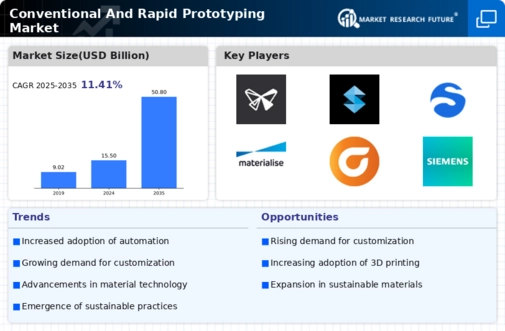Cost Efficiency
Cost efficiency emerges as a critical driver for the Global Conventional And Rapid Prototyping Market Industry. Organizations are continually seeking ways to minimize production costs while maintaining quality. Rapid prototyping techniques, such as additive manufacturing, enable companies to produce prototypes with less material waste and reduced labor costs. This efficiency is particularly beneficial for startups and small businesses that may have limited budgets. By leveraging these cost-effective methods, firms can allocate resources more effectively, thereby enhancing their competitive edge in the market. This trend is expected to support the industry's growth trajectory in the coming years.
Sustainability Initiatives
Sustainability initiatives increasingly influence the Global Conventional And Rapid Prototyping Market Industry. As environmental concerns gain prominence, companies are adopting eco-friendly practices in their prototyping processes. This includes utilizing biodegradable materials and reducing energy consumption during production. The shift towards sustainable prototyping not only aligns with global environmental goals but also appeals to environmentally conscious consumers. Industries such as fashion and automotive are leading the charge in implementing sustainable practices, thereby enhancing their brand image. This trend is likely to shape the market dynamics significantly in the years ahead.
Technological Advancements
The Global Conventional And Rapid Prototyping Market Industry experiences substantial growth driven by continuous technological advancements. Innovations in materials and processes enhance the efficiency and effectiveness of prototyping methods. For instance, the introduction of advanced 3D printing technologies allows for quicker iterations and improved design accuracy. As a result, companies can reduce time-to-market significantly, which is crucial in competitive sectors such as automotive and aerospace. This trend is expected to contribute to the market's valuation of 15.5 USD Billion in 2024, with projections indicating a potential rise to 50.8 USD Billion by 2035.
Globalization of Supply Chains
The globalization of supply chains significantly impacts the Global Conventional And Rapid Prototyping Market Industry. As businesses expand their operations internationally, the need for efficient prototyping solutions becomes paramount. Rapid prototyping allows companies to develop and test products in various markets quickly, ensuring they meet local demands and preferences. This adaptability is crucial in sectors like consumer goods and electronics, where market conditions can vary widely. The ability to respond swiftly to global market trends is likely to drive the industry's growth, fostering innovation and collaboration across borders.
Increased Demand for Customization
The demand for customization in product development propels the Global Conventional And Rapid Prototyping Market Industry forward. As consumers increasingly seek personalized products, manufacturers are compelled to adopt rapid prototyping techniques that facilitate bespoke designs. This shift is particularly evident in industries such as consumer electronics and healthcare, where tailored solutions are paramount. The ability to produce unique prototypes quickly not only enhances customer satisfaction but also fosters innovation. Consequently, this driver is likely to play a pivotal role in achieving a compound annual growth rate of 11.41% from 2025 to 2035.





















Leave a Comment